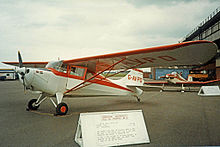This is an old revision of this page, as edited by 2402:3a80:6ee:272e:0:63:c46f:ee01 (talk) at 11:23, 7 December 2019 (→Current: Added content). The present address (URL) is a permanent link to this revision, which may differ significantly from the current revision.
Revision as of 11:23, 7 December 2019 by 2402:3a80:6ee:272e:0:63:c46f:ee01 (talk) (→Current: Added content)(diff) ← Previous revision | Latest revision (diff) | Newer revision → (diff)| HUL-26 Pushpak | |
|---|---|

| |
| HUL-26 Pushpak displayed at HAL Museum | |
| Role | Two-seat cabin monoplaneType of aircraft |
| Manufacturer | Hindustan Aeronautics Limited |
| First flight | 1958 |
| Primary users | Aero Clubs Private pilot owners |
| Number built | 160+ |
The Hindustan HUL-26 Pushpak was a 1950s Indian two-seat cabin monoplane designed and built by Hindustan Aeronautics Limited, based on the Aeronca Chief.
Construction and operation
The Pushpak was a high-wing braced monoplane with a fixed tailwheel landing gear. The fuselage was built from metal tubing, the wing aluminum ribs on a wooden spar, all covered in fabric. The Pushpak first flew on 28 September 1958 and was powered by a 90 hp (67 kW) Continental flat-four engine.
Around 160 aircraft were produced for Indian flying clubs for use as basic trainers. Two examples were gifted to Malaysia and were later sold to private pilot owners in the United Kingdom. These examples remained in active operation in 2013.
Operators

Current
United Kingdom's
Former
- One gifted by India
Specifications (HUL-26)
Data from Jane's All The World's Aircraft 1965–66
General characteristics
- Crew: 2
- Length: 6.40 m (21 ft 0 in)
- Wingspan: 10.97 m (36 ft 0 in)
- Height: 2.77 m (9 ft 1 in)
- Wing area: 16.2 m (174 sq ft)
- Empty weight: 395 kg (871 lb)
- Max takeoff weight: 613 kg (1,351 lb)
- Fuel capacity: 56 L (12 imp gal; 15 US gal)
- Powerplant: 1 × Continental C90-8F air-cooled flat-four, 67 kW (90 hp)
Performance
- Maximum speed: 144 km/h (89 mph, 78 kn)
- Cruise speed: 112 km/h (70 mph, 60 kn)
- Range: 400 km (250 mi, 220 nmi)
- Endurance: 3 hr
- Service ceiling: 4,270 m (14,010 ft)
- Rate of climb: 2.5 m/s (500 ft/min)
References
- Notes
- ^ Orbis 1985, p. 2172 harvnb error: no target: CITEREFOrbis1985 (help)
- Air-Britain 2013, p. 603 harvnb error: no target: CITEREFAir-Britain2013 (help)
- Taylor 1965, p. 80
- Bibliography
- Taylor, John W. R. (1965). Jane's All The World's Aircraft 1965–66. London: Sampson Low, Marston & Co., Ltd.
{{cite book}}: Invalid|ref=harv(help) - The Illustrated Encyclopedia of Aircraft (Part Work 1982-1985), 1985, Orbis Publishing, p. 2172.
- Partington, David (2013). Civil Aircraft Registers of United Kingdom, Ireland & IOM 2013. Tonbridge, Kent: Air-Britain (Historians) Limited. ISBN 978-0-85130-453-3.
{{cite book}}: Invalid|ref=harv(help)
| Hindustan Aeronautics Limited (HAL) aircraft | |||||||||||||||||
|---|---|---|---|---|---|---|---|---|---|---|---|---|---|---|---|---|---|
| Indigenous |
| ||||||||||||||||
| Jointly developed |
| ||||||||||||||||
| Under license |
| ||||||||||||||||
| (*) are under development | |||||||||||||||||
This article on an aircraft of the 1950s is a stub. You can help Misplaced Pages by expanding it. |